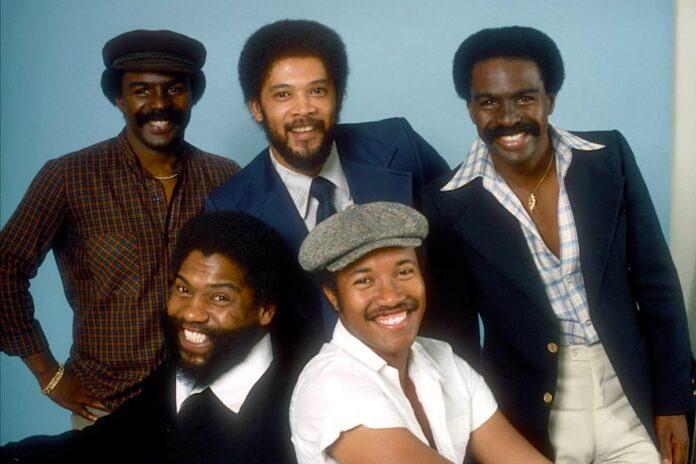“I Can Make It Better,” one of two singles from The Whispers‘ album Imagination, produced by SOLAR Records’ main in-house producer Leon F. Sylvers III, had R&B charts, Black Elks Lodge jukeboxes, and Soul Train lines jumping high in early 1981. Not the most popular song on the album—“It’s A Love Thing” dominated roller rinks from Brooklyn to Detroit and back—“I Can Make It Better” always felt defiantly bold. Courageously funky.
Yes. I get it. “And the Beat Goes On” from 1978 remains an earworm for survival, the archetypical “let’s keep it movin’” statement for an earlier generation, while “It’s A Love Thing” kept on uniting families, found or genetic, under one roof, in the park, at the Steppers formal or used in Black Fraternity stepshows. These two multi-cultural declarations would keep The Whispers on tour for 40-plus years. Along with the 15 top 10 R&B singles, eight top ten R&B Albums, seven gold, two platinum, and one double platinum albums, as well as the 40 charting hit singles since 1970. Fans, not the fickle pop charts, not American Bandstand, kept Whispers loyalty, coming back to their performances each summer, identical to the way Maze featuring Frankie Beverly stayed true to their legions of devotees.
Upon hearing of the passing of Walter Scott Jr. on June 26, at 81, after a six-month battle with cancer, it was the big, bold, sweeping charts of “ I Can Make It Better,” its marching on in the face of adversity groove, that got me. Walter led the Whispers as vocalist with his twin Scotty, along with members Nicholas Caldwell, Marcus Hutson, and Gordy Harmon in the early 1960s. In one light, the song is a conversation between paramours. But upon closer inspection, I imagine that at the time it served as a way of boosting the energy to many who were the first-line recipients of Reaganomics circa 81. Yes. This disco-post-disco—let’s just call it for what it is, jam for the ages—musically challenged anybody to say a negative word about the grand-scale beauty and eternal optimism of dance music.
Listen, my uncle had a Whispers collection, starting with “Headlights” (I’ll let you Google that cover art), so Imagination had a worn quality to the album cover. The edges show how loved this record was. It got played when the kids were around… and not. Day and night, summer and winter, for family and social entertainment. See, nobody back then called this music boogie. “You got that new Whispers” was all the definition you needed. Within those two words came a War & Peace chapter’s worth of description, amongst those in the know. They personified that different era of a group who only needed one mic on stage, they would handle the singing, the choreography, the harmonies-No sweat.
Their music welcomed everybody. It informed uncles what new fits they needed in the rotation, just by gazing at their album covers, and in the same light reminded your aunties that there were men, Black men, who respected all the virtues of true love. It may sound a bit corny, but sometimes corny can renew your faith in humanity. The Whispers provided joy immediately, no matter if things were good or bad. They kept that candle of positivity on, and shoot, it smelled good. From Larry Levan’s dance floor to Frankie Crocker’s make-it-or-break-it playlist at WBLS New York, Black radio, and, in general, elevated sound production aficionados clamored for what the Whispers later came to represent: The smooth, slick genesis that soul music morphed into after disco’s popularity came under attack. Due to fear.
That wasn’t the only change happening in the country, either. Soul music was being run, not by New York, Chicago, Memphis, or Philly, but by Los Angeles. The powerful SOLAR imprint, an acronym for Sound of Los Angeles Records, was launched and executed over by Dick Griffey, who played a crucial role in the early development of Soul Train, starting as a talent coordinator and later becoming a partner in Soul Train Records alongside Don Cornelius. In 1978, Griffey acquired the rights to Soul Train Records and its artists, incorporating them into SOLAR. It initiated the rise of this glossy LA boogie sound, featuring Dynasty, Shalamar, Midnight Star, Lakeside, and of course, The Whispers.
Starting as a doo-wop group, formed in Watts in 1963, The Whispers were summoned to Oakland in 1966 by then-Bay Area popular DJ Sly Stone. The group’s roots as a barbershop vocal harmony act and their gradual transformation into something funkier immediately gelled here. Questlove described the Whispers sound best: “non-aggressive disco, smooth enough that your grandparents could get down to. They took the doo-wop cornerstore/bathroom harmony of the ’50s and ’60s, took the soul of the ’70s, and the smooth elegance of the ’80s and served it well—no chaser. Although they were denied true pop accolades, they still made an impact.”
“I Can Make It Better” features producer Slyvers’ engaging electric bass line at the start, tinkling bells throughout, and a slow string melody that comes in just after the second verse, tweaking dance music a bit, bringing it into modernity, merging disco-funk with an unmistakable old school charm. The underlying message is clear: “Folks, we’re going to be alright.”





